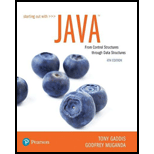
EBK STARTING OUT W/JAVA:...DATA...
4th Edition
ISBN: 9780134757179
Author: GADDIS
Publisher: PEARSON CO
expand_more
expand_more
format_list_bulleted
Expert Solution & Answer
Chapter 18.1, Problem 18.7CP
Explanation of Solution
Iterator:
Iterator is used to access data in the collections without relieving how data stored in the data structure.
Iterator interface has the “iterator()” method, which returns iterator object. Iterator method is used for traversing data in an orderly fashioned manner.
Data in the collections that can be accessed using the following three methods,
- next() – Accessing the next elements in the iterator.
- hasNext() – To check more elements are available in the iterator.
- remove() – To delete the last element returned by the iterator.
Example:
//Import the java package
import java.util.*;
public class Sample
{
//Main method
public static void main(String[] args)
{
//Creating new array list
Collection<String> collection = new ArrayList<>();
//Adding new elements to the list
collection.add( "Apple" );
collection.add( "Orange" );
collection ...
Expert Solution & Answer
Want to see the full answer?
Check out a sample textbook solution
Students have asked these similar questions
What is an abstract clas s ?
How does concrete RTN differ from abstract RTN. Give examples.
Explain the design pattern followed by Iterator
Chapter 18 Solutions
EBK STARTING OUT W/JAVA:...DATA...
Ch. 18.1 - Prob. 18.1CPCh. 18.1 - What are the three general types of collections?Ch. 18.1 - Prob. 18.3CPCh. 18.1 - Prob. 18.4CPCh. 18.1 - Prob. 18.5CPCh. 18.1 - Prob. 18.6CPCh. 18.1 - Prob. 18.7CPCh. 18.2 - Prob. 18.8CPCh. 18.2 - Prob. 18.9CPCh. 18.2 - Prob. 18.10CP
Ch. 18.2 - Prob. 18.11CPCh. 18.2 - Prob. 18.12CPCh. 18.2 - Prob. 18.13CPCh. 18.2 - Prob. 18.14CPCh. 18.2 - Prob. 18.16CPCh. 18.2 - Prob. 18.17CPCh. 18.2 - Prob. 18.18CPCh. 18.2 - Prob. 18.20CPCh. 18.3 - Prob. 18.21CPCh. 18.3 - Prob. 18.22CPCh. 18.3 - Prob. 18.23CPCh. 18.3 - Prob. 18.24CPCh. 18.3 - Any time you override the Object classs equals...Ch. 18.3 - Prob. 18.26CPCh. 18.3 - Prob. 18.27CPCh. 18.3 - Prob. 18.28CPCh. 18.4 - Prob. 18.29CPCh. 18.4 - Prob. 18.31CPCh. 18.4 - Prob. 18.32CPCh. 18.6 - How do you define a stream of elements?Ch. 18.6 - How does a stream intermediate operation differ...Ch. 18.6 - Prob. 18.35CPCh. 18.6 - Prob. 18.36CPCh. 18.6 - Prob. 18.37CPCh. 18.6 - Prob. 18.38CPCh. 18.6 - Prob. 18.39CPCh. 18 - Prob. 1MCCh. 18 - Prob. 2MCCh. 18 - This type of collection is optimized for...Ch. 18 - Prob. 4MCCh. 18 - A terminal operation in a stream pipeline is also...Ch. 18 - Prob. 6MCCh. 18 - Prob. 7MCCh. 18 - This List Iterator method replaces an existing...Ch. 18 - Prob. 9MCCh. 18 - Prob. 10MCCh. 18 - This is an object that can compare two other...Ch. 18 - This class provides numerous static methods that...Ch. 18 - Prob. 13MCCh. 18 - Prob. 14MCCh. 18 - Prob. 15TFCh. 18 - Prob. 16TFCh. 18 - Prob. 17TFCh. 18 - Prob. 18TFCh. 18 - Prob. 19TFCh. 18 - Prob. 20TFCh. 18 - Prob. 21TFCh. 18 - Prob. 22TFCh. 18 - Prob. 1FTECh. 18 - Prob. 2FTECh. 18 - Prob. 3FTECh. 18 - Prob. 4FTECh. 18 - Write a statement that declares a List reference...Ch. 18 - Prob. 2AWCh. 18 - Assume that it references a newly created iterator...Ch. 18 - Prob. 4AWCh. 18 - Prob. 2SACh. 18 - Prob. 4SACh. 18 - Prob. 5SACh. 18 - Prob. 6SACh. 18 - How does the Java compiler process an enhanced for...Ch. 18 - Prob. 8SACh. 18 - Prob. 9SACh. 18 - Prob. 10SACh. 18 - Prob. 11SACh. 18 - Prob. 12SACh. 18 - Prob. 13SACh. 18 - Prob. 14SACh. 18 - Word Set Write an application that reads a line of...Ch. 18 - Prob. 3PCCh. 18 - Prob. 5PCCh. 18 - Prob. 8PC
Knowledge Booster
Similar questions
arrow_back_ios
SEE MORE QUESTIONS
arrow_forward_ios
Recommended textbooks for you
